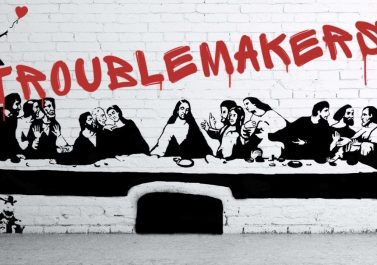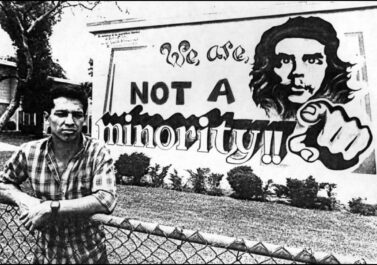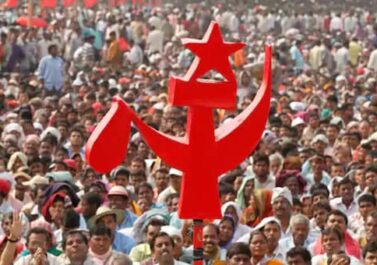
We edited this text by comrades from Faridabad Majdoor Samachar (Faridabad Workers’ News) slightly. We think that despite its anecdotal nature the text is relevant for the discussion of the relationship between workers and the (Maoist) ‘far left’. For working class internationalism!
————
* Nagender ji, Vice President of IMK (Revolutionary Worker Centre), a Marxist-Leninist organisation, died on 10th June in Delhi at the age of 47 due to cancer.
* A split from the RSPI (M-L), which was a pure Leninist organisation, the Revolutionary Proletarian Platform was also a pure Leninist organisation (denunciation of Stalin-Trotsky-Mao from the word go). The editor of IS (Revolutionary Proletariat) Jagdish ji had started coming from Basti in eastern Uttar Pradesh state to Faridabad to meet us. He used to forcefully say that the “Platform” was not an organisation, rather it was for discussion. Jagdish ji insisted on our participation in a three day discussion in Gorakhpur in 1983. Then, as an exception, Vijay Shankar and I, from Majdoor Samachar, went to Gorakhpur as observers.
At dinner, on the eve of the discussions, we raised some questions on their slogan “Have four hours work, do away with unemployment”, which the Platform had adopted from their earlier organisation. The definition of a working day as per Marx: ‘Number of hours of work per day by a worker, the wage for which will suffice for raising his family.’ In the 1880s, the demand for an eight hours working day was raised. During these hundred years, significant increases in the pace of production and a decrease in worker’s family size have taken place, but still factory worker’s working day in the present is on the 12-16- … hours trajectory. Eight hour shift does not mean eight hour working day, as often multiple family members work in order to earn a family wage. The uneasiness of the leadership of people who had come from Bengal, Maharashtra, Bihar, UP etc. states was visible.
On first day of “the discussion”, leaders took their cadres aside and gave them a lecture. Later we came to know that this was their tradition. After seeing this for some time, we waited for discussion at night. Three days of waiting. While packing on the final day, we asked Kuldeep, a young lawyer from Basti. He had made the journey from a student leader in Gorakhpur University, to a Maoist, to a pure Leninist. Kuldeep informed us: After the dinner discussion, the leadership decided that a mistake had been made by inviting us; raw, not fully formed yet, cadres; no discussion to be held. Eight hundred kilometre travel and three days of waiting. Well, during our Maoist phase, we had experienced such waitings a few times.
* Then we met Dr. Lal Bahadur, Professor of History in Gorakhpur University. Lal Bahadur ji gave us a publication of CLI (M-L), which was formed by Shri Ramnath after leaving the CPI (M-L). Even after several divisions in the CPI (M-L), the basic premise of the groups has been: India is a semi-colonial semi-feudal country; stage of revolution is democratic-new democratic; task of the workers party is to prepare peasants for the revolution. Following the footprints of Lenin, who had characterised workers as revolutionary in Russia against the Narodniks assertion of peasants as revolutionary, the CLI (M-L)’s premise now was: India is a capitalist country; stage of revolution is socialist; prepare workers for revolution. And, Mao continued to be their beacon. In Lal Bahadur ji’s house, we also met Ravinder, a research scholar from Delhi University. An advice of Ravinder ji is still fresh in memory: leave what you are doing; do Ph.D. in the university; take fellowship from the government; prepare revolutionaries from amongst the students. From being immersed in preparing revolutionaries from students in Delhi University, with time, Ravinder ji distanced himself from revolution and became a college teacher in Delhi.
* By 2000, almost all Maoist organisations had started giving importance to working amongst factory workers. By the way, the CLI, which had been talking of focussing on factory workers from 1983, was also immersed in peasants-students well beyond 2000, and as a tendency had split into three-four groups. After 2004, we had some interactions in Faridabad/Gurgaon with IMK and Bigul factions of CLI. Having awakened the peasants — made conscious, made revolutionary with Mao’s teachings — the revolutionaries now took up the new task of awakening the workers, arming them with consciousness, making them revolutionary. On the basis of Lenin’s 1903 book, “What is to be done?”, as a first lesson, maoist organisations started teaching factory workers to form unions.
In 1903, unions on the basis of trade orcraft were in vogue in factories. When the First World War began, trade unions in every country in Europe supported their country/government. The meaning of support for war for workers is massive increase in exploitation. So, in Germany, trade unions stronghold then, as soon as the war came to an end, workers revolted against trade unions and that workers’ upsurge had become a challenge to state power. The self-proclaimed workers’ Marxist party and trade unions played an important role in crushing that workers’ upsurge. At that time, as an alternative to trade-craft unions, workers tried industrial unions in which all workers of a factory, whatever be their trade-craft, could be members. But soon, factory unions proved to be just like trade unions.
On the basis of Lenin’s book, “What is to be done?”, Majdoor Samachar’s efforts in Faridabad during 1982-84 were rejected by factory workers. We suspended the publication, after year-long readings and reflections, a new series of Majdoor Samachar was started on a new basis in 1986. In 1982, most of the workers in factories were permanent workers. In India, factory unions have been the norm for more than sixty years.
* Since 2000, temporary workers in factories have increased very rapidly. When maoist revolutionaries began imparting knowledge of union formation to factory workers, at that time most of the factory workers had become temporary workers. Industrial Disputes Act under the Constitution of India has been the primary labour legislation. As per this law, in factories, workers hired through contractor companies and directly hired workers for 6-7 months (casual workers), were not “workmen”. And, as per the Trade Union Act, only workmen could become members of a factory union. With temporary workers not being “workmen”, hence, even as per law, most factory workers were out of the union arena. In such a scenario, the role of unions in controlling workers had normally become insignificant for companies. Factory unions had become irrelevant.
But, in new factories, permanent workers also have to work and their wages are also not high. In this situation, relations between permanent and temporary workers develop rapidly. In about five years, co-ordinations between permanent and temporary workers increase to such an extent that it becomes indispensable for the management of the factory and the government to break the co-ordinations amongst workers. And then, much more than the central unions (AITUC, CITU, HMS, BMS, INTUC) that have almost vanished from industrial areas, it is maoist groups that propagate the formation of unions.
Two examples – Maruti Suzuki and Honda Tapukara struggles
* Production commenced in the Maruti Suzuki Manesar factory in 2007. Co-ordinations amongst permanent workers, trainees, workers hired through contractor companies, and apprentices developed to such a level that in June 2011 workers removed the control of the company and the government over the factory for 13 days. Three thousand workers stayed day and night in the factory. There was a big demand for Maruti cars in the market but production was stopped by the workers. The workers were simply not listening to the existing union. Maoist groups were more active than others in advocating the formation of another union in Maruti Manesar. Young Maruti workers listened to everyone but acted as per their evaluation. Because of this, Maruti management and the government failed to establish control over the workers.
Then as per plan, the management had all the workers out of the factory for a month (September 2011). Attempted production by keeping new workers in the factory under police protection. This failed. Then Maruti management sent a manager to Chandigarh (state capital) and got the new union registered! Without any negotiations, the company gave significant concessions: assembly of a car per minute instead of one every 45 seconds; raised wages and allowances; increased holidays etc. But even then, Maruti Manesar workers remained out of the management’s control. “What do workers want?” had become an indecipherable riddle for government, company, party-union leaders.
Not in any frenzy, but rather in an almost routine situation, on the evening of 18 July 2012 workers of two shifts in Maruti Manesar factory attacked the wages-system. Thousands of workers attacked two symbols of the wages-system: factory buildings and managers. One manager died in the attack. And on that day, on 18 July members of revolutionary organisations were making phone calls to the new leaders of the new union: Stop the workers! And from inside the factory, new union leaders were saying that if they tried to stop the workers, they would be the first to be dealt with by the workers. Stunned by the upsurge of Maruti Manesar workers, the government stationed 600 commandos permanently in Industrial Model Town, Manesar. District Court, High Court, Supreme Court refused bail to the 147 arrested workers. Maruti management immediately terminated the services of around three thousand temporary workers and discharged 546 out of the 950 permanent workers.
That upsurge of workers in Manesar had terrorised managers in factories in Faridabad. Maruti management announced to stop using workers hired through contractors, something which no official trade union struggle ever achieved.
And … and two dozen revolutionary organisations printed fifty thousand handbills in which the story of helpless-oppressed-victim workers was concocted. As per revolutionaries, there was no initiative of the workers. Maruti management had conspired. Workers were attacked by bouncers. In reaction, workers had only defended themselves…
Despite significant concessions given by the company and the government, the attack of young Maruti Manesar workers on the wages-system has given it a global significance.
And, union-party leaders of various hues accelerated their efforts to create swamps. The first step was to shift the solidarity actions for incarcerated workers from Manesar, where the factory is located, to Gurgaon. The terminated temporary workers soon disappeared from the focus of the solidarity actions, but the 546 discharged permanent workers and the families of workers in prison became a captive audience. And then, they shifted activity to far away Kaithal in a rural setting. In an year’s time, it came to this:
On 18 July 2013, the first anniversary of the workers’ uprising, two dozen revolutionary organisations with police permission held a function in Leisure Valley Park in Gurgaon. With lighted candles in daytime and carrying the portrait of the dead manager, the last rites of revolutionary organisations were performed. It will be appropriate to mention here what a member of a revolutionary organisation, well acquainted with what happened on 18 July 2012 in Maruti Manesar factory said, “Privately I will say that yes, the workers did this. But publicly I will say that the Maruti management conspired and bouncers attacked the workers …”
* Production in the two-wheeler Honda factory in Tapukara, Alwar district, Rajasthan commenced in 2011. By 2016, such co-ordinations had developed amongst four hundred permanent workers and four thousand temporary workers that the workers removed Honda management’s control over the factory. Workers sat down inside the plant. Police attacked and forced the workers out of the factory. And once again, central unions and revolutionary organisations played the symphony: they demanded the constitutional right to form a union. When, as per law under the Constitution, four thousand temporary workers could not even become members of the factory union.
Central union leaders and revolutionary organisations first called Honda Tapukara workers to Gurgaon. Then they told them to go to Rajasthan capital Jaipur. Then to Alwar. And then the masterstroke: Jantar Mantar in Delhi, the ‘government district’ and indefinite hunger strike by workers. Thus was the situation created wherein some workers of Honda Tapukara brought Ganges water in a truck to propitiate Lord Shiv to impart good sense to Honda management…
* In my memory, the image of Nagender ji is that of a IMK spokesperson. Back to Gorakhpur …
In July 2010 in Gorakhpur, CLI faction Bigul convened a three day function regarding “Workers movement in India in the 21st century”. Majdoor Samachar attended as an observer. As it happens after any split in a sect, dispute regarding the real one amongst the factions is what took place in Gorakhpur. Bigul people from Punjab, Delhi, UP had come to Gorakhpur in full strength. And from IMK side, Nagender ji held the fort. For three days, one after another fighter from Bigul attacked and Nagender ji held on to the IMK positions. Workers in the 21st century… were nowhere in sight.



